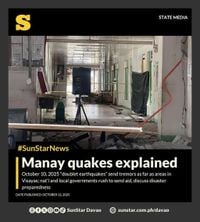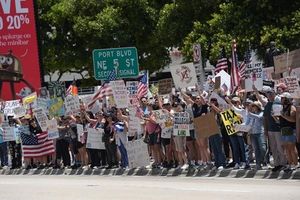On October 10, 2025, the tranquil province of Davao Oriental in the southern Philippines was rocked by a pair of powerful earthquakes—one measuring magnitude 7.4, the other 6.8. These twin tremors, known in seismological circles as a "doublet earthquake," struck offshore from the town of Manay and left a trail of devastation that continues to haunt the region days later. The Philippine Institute of Volcanology and Seismology (Phivolcs) classified the event as a doublet because the two main shocks occurred in close succession and proximity, each with its own destructive force, according to the Philippine Daily Inquirer.
By October 14, the death toll had risen to nine, with the Office of Civil Defense (OCD) confirming the latest fatality early that morning. "Last night, we had eight reported fatalities in Davao Region but early this morning, one additional death was recorded so as of noontime, the number of deaths that are still subject for validation has already reached nine," OCD spokesperson Junie Castillo stated, as reported by Manila Bulletin and echoed by GMA Integrated News. The toll is still pending final validation, but the pain and uncertainty it represents are all too real for the families involved.
The scale of the disaster is staggering. According to the National Disaster Risk Reduction and Management Council (NDRRMC), as of October 14, the earthquakes had affected 200,914 families—comprising a total of 845,001 individuals—in Davao Region (Region 11) and neighboring Caraga (Region 13). Some reports, such as those from GMA Integrated News, place the number even higher, with up to 889,000 people impacted by the tremors and their aftermath. The discrepancy in figures highlights the fluid and chaotic nature of disaster response, as authorities race to tally the full extent of the damage.
In the immediate aftermath, communities scrambled to find shelter and safety. Approximately 12,768 people—representing 3,176 families—sought refuge in eight evacuation centers, according to the OCD and NDRRMC. Another 192 individuals found temporary lodging outside these centers, often in open spaces or at the homes of friends and relatives, driven by lingering fears of aftershocks. The psychological toll is impossible to quantify, but the sight of families huddled in makeshift quarters is a stark reminder of the earthquakes' impact.
And aftershocks there were—by the dozen. Phivolcs reported a staggering 1,281 aftershocks as of 8:00 a.m. on October 14, with 604 plotted and at least 15 strong enough to be felt by residents. Later that day, the number had risen to 1,303, with 18 felt and magnitudes ranging from 1.2 to 5.8, according to GMA Integrated News. Each tremor, no matter how small, rattled nerves and complicated ongoing relief efforts.
The physical destruction is evident everywhere. The NDRRMC and OCD both reported that 2,575 houses were damaged in the quakes—2,231 partially and 344 totally destroyed. For families whose homes were torn apart, the loss is both material and emotional. Men could be seen picking through the ruins of collapsed houses in Manay, searching for salvageable belongings amid the debris, as captured in poignant photographs shared by AFP and other news agencies.
Beyond homes, the region's infrastructure suffered a heavy blow. The initial estimated cost of damage exceeded ₱100 million, affecting at least 273 structures, including schools, government offices, and public facilities. That figure is expected to rise as assessments continue. "The initial estimated cost of damage to infrastructure has reached over ₱1.258 million although the number is expected to further rise as assessments are still ongoing," reported Manila Bulletin. The scale of destruction has tested the limits of local and national response capabilities.
Yet, amid the devastation, there has been a robust and coordinated response. The NDRRMC reported that ₱39,989,124 in assistance has already been provided to affected families. Relief efforts have focused on providing food, water, shelter, and medical care to the displaced and injured. As of October 14, 403 individuals had been reported injured across the affected regions, with 23 cases confirmed by the NDRRMC. Thankfully, no one was reported missing, a small mercy in an otherwise grim tally.
The earthquakes have prompted a nationwide reckoning with disaster preparedness. NDRRMC Chairperson and Defense Secretary Gilberto Teodoro Jr. issued a call to action, urging all local government units (LGUs) and national government agencies (NGAs) to review and update their contingency plans. "It is important for every local government unit and agency to review their contingency plan to determine our capacity in terms of response mechanisms, what resources are available, and what gaps need to be addressed," OCD spokesperson Junie Castillo emphasized, as quoted by Manila Bulletin. Teodoro also encouraged the intensification of earthquake drills, especially in public spaces such as schools and government offices, to ensure readiness for future disasters.
Earthquake drills are nothing new in the Philippines—a country that sits squarely on the Pacific Ring of Fire and is no stranger to seismic activity. The OCD conducts nationwide simultaneous earthquake drills four times a year, but the recent events in Davao Oriental have underscored the need for even greater participation and vigilance. "Everyone must take part. It can’t be that only a few are trained. Everyone should know what to do in case an earthquake occurs," Castillo insisted. The message is clear: disaster resilience is a collective responsibility, and complacency can be deadly.
The science behind doublet earthquakes is still being studied, but the experience in Davao Oriental offers a sobering case study. According to Phivolcs, a doublet involves two or more main shocks occurring in nearly the same area, with only slight differences in magnitude. The close timing and proximity can amplify damage, as structures already weakened by the first quake are left even more vulnerable to subsequent shocks. The October 10 event fits this pattern, with both quakes striking off the coast of Manay within a short window.
For the people of Davao Oriental and the surrounding regions, the road to recovery will be long and fraught with challenges. Rebuilding homes and infrastructure, restoring livelihoods, and tending to the emotional scars left by the disaster will require sustained effort and solidarity. But as the dust settles, there are signs of hope and resilience. The swift mobilization of aid, the determination of local communities, and the renewed focus on preparedness all point to a future where the lessons of this tragedy are not forgotten.
In the wake of the doublet earthquakes, Davao Oriental stands as a testament to both the destructive power of nature and the enduring strength of the human spirit. The numbers tell a story of loss, but the faces behind them speak of courage, compassion, and the unwavering will to rebuild.




